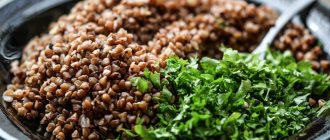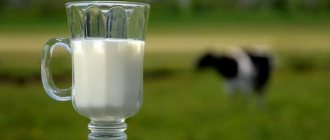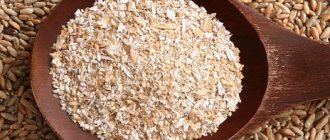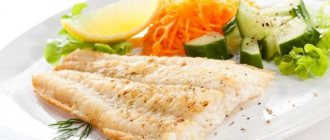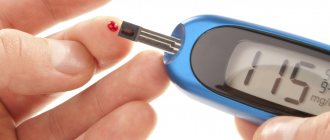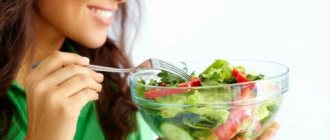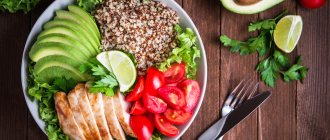General rules of nutrition for diabetes
Currently, diabetes is a global problem. Over the past ten years, the number of people suffering from diabetes has more than doubled and reached 425 million. According to forecasts, by 2045 their number could reach 629 million.
Diabetes
is a group of endocrine diseases associated with impaired glucose absorption and developing as a result of an absolute or relative deficiency of the hormone insulin, resulting in the development of hyperglycemia - a persistent increase in blood glucose levels. This disease is characterized by a chronic course, as well as a violation of all types of metabolism due to a violation of carbohydrate metabolism; fat, protein, mineral and water-salt metabolism are also disturbed.
Let's look at the reasons for the development of this disease. Type 1 diabetes is characterized by the destruction or destruction of pancreatic cells. This usually leads to absolute insulin deficiency. The development of type 1 diabetes involves both genetic and environmental factors - viral infections, nutrition, toxins, hygiene. Type 2 diabetes mellitus is characterized by the development of insulin resistance and relative, rather than absolute, insulin deficiency and is manifested by persistent hyperglycemia. The main problem with any type of diabetes is an increase in blood glucose levels and carbohydrate starvation of cells, since glucose cannot enter it, but floats idle in the blood.
The treatment of diabetes mellitus is based on diet therapy. The general principles of nutrition, regardless of the type of diabetes, are that the patient is advised to reduce the carbohydrate load in the diet to 5-7% and increase the consumption of vegetable fats. Previously, diabetics were recommended to completely eliminate simple carbohydrates, but today there is an increasing emphasis on personalized diets with an individual selection of food baskets and calorie calculations. Currently, the slogan is very popular: “With diabetes there are no restrictions, there is only the right lifestyle.”
The diet for patients with diabetes is based on the glycemic index. Essentially, this index reflects the speed at which sugar from them is absorbed into the blood. Products with a high index - jam, cookies, cakes - have a high absorption rate. Products with a low index - cereals, fruits - have a lower index. The slower the absorption rate, the easier it is for the pancreas to cope with the load. Thus, foods with a GI of up to 55 are broken down gradually and almost do not cause an increase in sugar.
Also, do not forget about the insulin index of foods, which reflects the amount of insulin rise in response to food consumption. The insulin index of foods is important to take into account for people with diabetes to predict the body's reaction when consuming specific foods and to correctly calculate the doses of insulin preparations (short and long-acting) that will be used for injection after meals.
Any meal, even protein, provokes a large release of the hormone insulin. And the more insulin swings you have during the day, the more likely you are to develop insulin resistance, which will subsequently lead to type 2 diabetes. Everyone’s favorite snack options in the form of dairy and fermented milk products, such as cottage cheese, kefir and yoghurt, have a very, very high insulin index, which means that the insulin swing will swing very strongly along with your mood and irritability.
Let's consider different options and features of diets depending on the type of diabetes.
Authorized and recommended products
The glycemic index and calorie content will help you figure out what foods you can include in your diet. The basis of the menu should be food rich in protein, fiber, cereals and legumes.
Protein
The main protein sources of the diabetic menu are:
- veal and lean beef;
- dietary varieties of poultry meat (chicken, turkey);
- rabbit meat;
- mushrooms (marinades are subject to restrictions);
- squid, shrimp, mussels and other seafood;
- fish: fatty varieties (halibut, stellate sturgeon, sardine, mackerel) - limited, low-fat varieties (pollock, navaga, blue whiting, pike) - unlimited;
- eggs.
Nuts help restore metabolism and normalize blood sugar levels. They contain a lot of protein and few monosaccharides. Recommended are walnuts and pine nuts, peanuts, and almonds. The consumption of nuts should be dosed, since all varieties are high in calories.
Vegetables, fruits, berries
What foods can lower blood sugar?
Low GI vegetables and fresh herbs should be mandatory in the daily menu. In addition to the products presented in the table (below), it is useful for diabetics to consume vegetables that can moderate glucose levels:
- Earthen pear or Jerusalem artichoke. This product stimulates endocrine processes in the pancreas to produce insulin.
- Momordica or bitter gourd. Activates metabolic processes, recommended for reducing and stabilizing body weight.
In addition to vegetables, fruits and berries should be an integral part of the diet. The liver does not require insulin to break down fruit sugar, so fructose is preferable to glucose for people with diabetes. It should be remembered that you can only eat fruits that have a low glycemic index, that is, they are not dangerous in relation to sugar surges. The list of allowed fruits includes:
- Apples. They have a beneficial effect on digestive processes.
- Pomegranate. Activates intestinal functions, helps hematopoiesis.
- Pears. Helps remove excess fluid from the body.
- Pomelo. Stabilizes the functioning of the heart muscle.
Berries recommended for illness:
- Kalina. Has the lowest glycemic index (10 units). At the same time, it contains a large amount of vitamins and helps lower blood pressure.
- Blueberry. Has a sugar-lowering effect. Prevents the development of rhinopathy (a complication of diabetes associated with vascular disorders of the retina).
Also useful will be: currants, lingonberries, blueberries, and other berries whose GI falls within the regulatory framework.
GI table of fruits and berries
| Oranges, pomegranate, quince, pear | 35 |
| Grapefruit, lemon | 25 |
| Avocado | 10 |
| Apples, peaches | 30 |
| Blueberries, blueberries | 42 |
| Cranberry | 45 |
| Lingonberry, blackberry | 25 |
| Currant | 30 |
The vegetable, berry and fruit components of the menu saturate the body with vitamins and minerals and help remove “bad” cholesterol. This helps improve the elasticity of blood vessels and prevents atherosclerosis.
Legumes and grains
Cereals must be selected taking into account the glycemic index. For diabetes, porridges made from wheat, pearl barley, and eggs are recommended. They allow you to maintain a feeling of fullness for a long time, protecting against changes in glucose levels. In addition, cereal dishes help improve digestive processes. Legume dishes help slow down the breakdown of nutrients, while they are rich in macro- and microelements. Processing legumes does not require insulin. The following must be included in the diet: beans, peas, lentils, chickpeas.
Spices
The participation of spices in the process of gluconeogenesis is that they inhibit the absorption of glucose into the systemic bloodstream. Diabetics can use spices such as oregano (oregano), cloves, and all types of pepper (ground black, red, white). The main spice used in medicinal nutrition is cinnamon. Its beneficial properties help control glycemia and prevent diabetic complications. Cinnamon can be added to porridge, cottage cheese dishes, and used as a seasoning for chicken or turkey.
Dairy and fermented milk products
The criteria for choosing products in this category should be calorie content, fat content, and amount of carbohydrates. Fruit fermented milk drinks (yogurt, fruit kefir) contain too much sugar and are contraindicated for people with diabetes. Milk and fermented milk products should not contain additives. Preference should be given to:
| Name | Fat content in % | Amount of carbohydrates | Calorie content |
| Kefir | 2,5 | 4,7 | 50 |
| Acidophilus | 3,2 | 3,8 | 56 |
| Natural Greek yogurt | 2,5 | 6–9 | 60–70 |
| Curdled milk | 2,5 | 4,2 | 53 |
| Cottage cheese | 1,8 | 3,3 | 101 |
| Adyghe cheese | 18 | 0 | 283 |
| Sour cream | 10–15 | 3 | 147–158 |
Basic nutrition rules for type 1 diabetes
In the first type, patients are completely dependent on insulin injections, and the diet is designed taking into account its administration. Diabetics need to study the presence of carbohydrates (bread units) in foods to determine the dose of the hormone that will help absorb them. A bread unit is a conventional concept that implies a certain amount of any product containing 12 grams of carbohydrates. It is recommended to consume no more than 12 bread units per day. Insulin is administered half an hour before meals, so it is important to know exactly what will be eaten and in what quantity to absorb the carbohydrates in the food. For each main meal you need to eat no more than 5-6 bread units and 2-3 for an additional one.
You should almost completely avoid foods containing easily digestible (simple) carbohydrates. These are sweets, jam, condensed milk, marshmallows, marmalade, halva, cakes, jam, etc., as well as oatmeal and semolina porridge, mashed potatoes. Reducing the amount of carbohydrates in your diet, which raise blood sugar, reduces the need for medications. Consuming the same dosages as before switching to a low-carbohydrate diet may cause hypoglycemia. It is necessary to measure your blood sugar regularly while starting this diet and adjust your medication dosage accordingly.
Daily caloric intake is distributed throughout the day into 4-5 meals. According to the BJU ratio, the distribution looks like this: proteins make up 20-25% of the total diet, fats - 30%, of which saturated no more than 10%, carbohydrates 45-50%.
Product selection criteria
Bread units
Daily norm of bread units:
- at the age of 2-5 years - no more than 13 XE;
- 6-9 years - no more than 15 XE;
- boys 10-15 years old - no more than 20 XE;
- girls 10-15 years old - no more than 17 XE;
- boys 16-18 years old - no more than 21 XE;
- girls 16-18 years old - no more than 18 XE;
- people over 18 years old - no more than 22 XE.
Distribution of XE by meals: breakfast, lunch and dinner - 5-6 XE; lunch, afternoon snack and 2nd dinner - 1-2 XE.
Glycemic index
This indicator will tell you what can and cannot be included in the diet:
- the product can be eaten if its GI < 40;
- you can eat it, but in limited quantities, if GI = 40-69;
- cannot be consumed if GI >70.
Complete GI tables with foods by food category
Calorie content
This indicator is necessary to keep weight within normal limits. Any deviations in both directions are fraught with diabetes. Obesity increases the risk of developing all complications several times and shortens life expectancy.
The recommended daily calorie intake for type I diabetes is 2000-2500 kcal. For type II without problems with excess weight - 1800-2000 kcal. For type II with obesity or simply overweight - 1500-1700 kcal.
For diabetic children, all numbers increase by 100-200 kcal, in adolescence - by 300-400.
With gestational diabetes mellitus, a pregnant woman should eat a nutritious and balanced diet. The daily calorie content of her diet should be at least 2,900 kcal, starting from the middle of the term. If there is a problem of excess weight, a reduction in calories by 200-300 units is discussed with a gynecologist and endocrinologist on an individual basis.
During lactation, if this diagnosis is present, you need to increase the daily calorie intake to 3,200 kcal.
Diabetics living in environmentally unfavorable areas, in areas with harsh climatic conditions, must adhere to the 3,000 kcal level.
All these figures are statistical averages, recommended without taking into account the individual characteristics of the body and the stage of the disease. Therefore, they must be adjusted for each individual patient and confirmed by the attending physician and nutritionist.
Now nutritionists are introducing a new concept into the nutrition of diabetics - the insulin index, which shows the intensity of changes in insulin levels in the body. Tables of products indicating it have already appeared, so you can consult with your doctor to see how applicable this technique is in your case.
Basic nutrition rules for type 2 diabetes
More serious restrictions are needed for non-insulin dependent variants of the disease. This is due to the fact that this form usually appears against a background of obesity, and not only high levels of glucose, but also insulin are found in the blood. However, it very often happens that insulin resistance, which can subsequently lead to type 2 diabetes, does not manifest itself for a very long time, and even people with insulin resistance are not always overweight, but the level of glucose in the blood is constantly high and This situation leads to very sad consequences. Dietary nutrition for type 2 diabetes helps restore cells' ability to absorb sugar and helps restore cell sensitivity to insulin.
Type 2 diabetes mellitus is primarily a disorder of carbohydrate metabolism. But at the same time, other types of metabolism suffer - lipid, protein, mineral. Treatment for type 2 diabetes mellitus includes diet, moderate exercise, stress management, and medications (diabetic drugs).
The diet for type 2 diabetes is based on key principles
:
- Abundance of vegetables
- The amount of vegetables consumed may depend on age, gender and frequency of exercise per week. As a general rule, women who exercise up to 30 minutes daily are advised to consume at least 500 grams of vegetables daily. For more intense exercise, it is recommended to increase the amount of vegetables to 800 grams. For men, the recommended amount of vegetables is 600 and 1000 grams, respectively.
- Unsaturated fats
— the presence of an adequate amount of polyunsaturated and monounsaturated fats in the diet allows you to maintain cholesterol levels within normal limits and reduces the risk of developing cardiovascular diseases, one of the most common long-term complications of diabetes. Unsaturated fats are found in many foods, including nuts, avocados, fatty sea fish, and olive oil.
- Avoid processed foods
— nutritionists and doctors agree that avoiding processed foods has a positive effect on health. Due to substances that are added to ensure a long shelf life, processed foods tend to have a high glycemic index. Regular consumption of such foods can negatively affect the health of a diabetic.
We recommend
“Products to increase hemoglobin: diet and dietary features” Read more
Basic principles of proper nutrition
People with diabetes need to change their eating behavior according to the following basic rules:
- eliminate monosaccharides (sweets) and other prohibited foods from the diet;
- observe the drinking regime and eating regime (every 3–4 hours);
- control the calorie content of dishes and the quantitative composition of nutrients;
- exclude from the menu dishes prepared by the culinary method of frying (food should not contain excess fat);
- introduce more vegetables, fruits and berries into the diet;
- limit the amount of salt consumed;
- be sure to have breakfast.
Important! You should stop drinking alcoholic beverages. Beer and wine have a high glycemic index. Strong alcohol puts a strain on the weakened pancreas, and also negatively affects the condition of blood vessels and disrupts the functioning of the heart.
To adjust the diet and start eating right, doctors recommend keeping a “diabetic diary” daily, where the patient notes the amount of food eaten, the composition of the dishes and the time of meal. This will help analyze the dependence of sugar levels on food. Diabetes mellitus, unfortunately, is incurable. If you cannot get rid of a disease, you need to learn to control it. With the help of diet therapy, you can improve your health and minimize the risk of complications.
Healthy foods for diabetes
- Green leafy vegetables
Spinach, cabbage and bok choy are low in calories but rich in nutrients such as vitamin C, beta-carotene and magnesium, which help prevent diabetes. One serving (about 106 g) per day reduces the risk of developing type 2 diabetes by 14%.
- Legumes
These fiber-rich foods can help stabilize your blood sugar levels. Legumes are low in saturated fat, which can be bad for your heart.
- Fish
Omega-3 fatty acids are great helpers in preventing diabetes and reducing the risk of cardiovascular diseases. Omega 3 is needed by the body for the synthesis of red blood cells and cell membranes, they help in the body’s absorption of other vitamins, and most importantly, they suppress chronic inflammation, which is a sure companion of insulin resistance.
- Olive oil
A staple of the Mediterranean diet, it is important for heart health as it is filled with monounsaturated fatty acids. These fats (also found in large quantities in nuts) are important in preventing diabetes by helping the body effectively control blood sugar levels.
- Nuts
As a source of monounsaturated fatty acids, nuts are rich in magnesium, another important nutrient. Global research shows that people who regularly eat nuts have lower rates of diabetes.
- Citrus
All citrus fruits contain antioxidants - great helpers in maintaining the balance of insulin in the blood.
- Whole grains
Eating whole grain bread, quinoa and brown rice reduces the risk of developing diabetes. Whole grains are rich in fiber, which helps the body control blood sugar levels. Complex carbohydrates are a kind of buffer that protects us from high rises in blood glucose, so if you want to eat a product with a high glycemic index, combine it with complex carbohydrates.
- Cinnamon
The tasty spice helps the body regulate insulin levels. Cinnamon is a kind of insulin sensitizer, that is, it helps improve cell sensitivity to insulin. The spice helps with hypertension (chronically high blood pressure), reduces the concentration of sugar in the blood when used systematically in the required dosages, improves overall well-being, and has a positive effect on metabolic processes.
- Ginger
It is a catalyst for metabolic processes, reduces sugar levels, cholesterol and blood clotting indicators. Recommended for daily consumption fresh as a seasoning or base for tea.
Carbohydrates
The main source of energy for humans is carbohydrates (about 2/3 of the entire diet), so we’ll start with them. These substances serve as a priority source of energy to power the brain, muscles and all other tissues in the body. That is, it is understood that they should always be available (in the blood, in the depot in the form of glycogen (liver and muscles)). However, their excess can lead to an increase in blood glucose levels, or to their conversion into fatty tissue and weight gain, which means you need to know which carbohydrates to choose and how much to eat.
The first group of carbohydrates are practically non-absorbable
They don't raise glucose levels enough for us to notice. This group includes
- Tomatoes
- cucumbers
- Salad
- Cabbage
- Broccoli
- Zucchini
- All green leafy vegetables
These foods can be eaten indefinitely without fear of increased blood sugar levels or weight gain.
Second group
Carbohydrates that are absorbed and can increase glucose levels, and they are divided according to the rate of absorption:
Very quickly absorbed
These are mono and disaccharides that begin to be absorbed in the oral cavity and have the ability to rapidly increase the concentration of blood glucose, so quickly that not a single glucose-lowering drug, including insulin, is able to prevent this. Even if 2 hours after eating the glycemia is within the target values, before that the blood sugar concentration rose to high values. To avoid this, you should not eat these foods. These products:
- Sugar
- Juice
- Sweet sparkling water
- Honey
- Grape
In case of hypoglycemia (glucose on the glucometer less than 3.3 mmol/l), you need to eat 4 pieces of sugar OR drink 200 ml of juice, other foods cannot raise sugar quickly enough to avoid the consequences of hypoglycemia
Fast absorbing
These are foods that contain longer chains of carbohydrates that are absorbed in the intestines after they are broken down by enzymes. Since carbohydrate chains are not very long, they break down quite quickly, hence the name of the group. Still, these products can be in the diet up to 1/3 of the total amount of carbohydrates. These products:
- All fruits
- Bananas. About them separately because each banana contains a lot of carbohydrates (about 2 XE (40 g)), which makes it possible to recommend their use only if it is the only source of carbohydrates, but not in combination with other products.
- Potato. Usually this product is perceived as “normal” food, the basis of the diet. It is wrong to prohibit eating it, but at the same time it is irrational, since it is quickly absorbed and you want to eat again very quickly, that is, you will experience hunger longer than if you eat slow carbohydrates instead, and this reduces the quality of life, which is inappropriate .
Slowly absorbed
These are foods containing very long chains of carbohydrates, so glucose rises extremely slowly and this process is well controlled by minimal doses of medication. These products should be in the diet in an amount of approximately 2/3 of all carbohydrates. This:
- Pasta. Not boiled or hard varieties so as not to overcook.
- Cereals. In addition to fine grinding, such as corn and semolina.
- Bread. “Good”, which translated from endocrinological means does not have a sweetish aftertaste.
- Rice. If you don't like him, that's fine. If you like it, then remember that it cannot be boiled to a mushy consistency; accordingly, you should give preference to the one that does not boil soft.
This group of foods on their own (cooked pasta, plain cereals and rice, and bread) will not lead to weight gain unless combined with the next group.
Prohibited foods for diabetes
Today, doctors try not to strictly limit patients with diabetes and not to force them into strict limits regarding permitted and prohibited foods. Even with type 2 diabetes, in which diet plays a role, you can eat a varied diet, but there are a number of foods that people suffering from this disease will still have to remove from the diet. In fact, the list below is recommended for anyone who cares about their health to exclude from their diet.
- Sweet
The black list includes sugar and all products containing it in excess. We must forget about ice cream, chocolate, marmalade, jam, sweets, preserves, halva and other sweets.
- Bakery
Sweet bakery products are prohibited: muffins, cookies, buns, white loaf and bread.
- Fatty foods
These dishes can greatly increase your glucose levels. For this reason, a diabetic should avoid duck, pork, lamb, lard, mayonnaise, and cream. It is also recommended to exclude sweet yogurt, fatty cottage cheese and cheese.
- Semi-finished products
They contain a large number of flavorings, stabilizers, and flavor enhancers. You should not eat fish sticks, ready-made industrial cutlets, dumplings, sausages, and sausages.
- Trans fats
Their consumption will harm not only a diabetic, but also a healthy person. Prohibited products include margarine, confectionery fat, spread, French fries, hot dogs, and burgers.
- Fruits
It is not recommended to consume certain fruits and dried fruits that cause a strong increase in blood sugar. Among them are dried apricots, dates, figs, raisins, persimmons, melon, grapes, bananas.
Counting method
Product labels almost always indicate the quantitative composition of nutrients per 100 g. To count bread units, it is enough to divide the number of carbohydrates by 12. For example, per hundred grams of finely ground oat flakes there are 54 g of carbohydrates, which equals approximately 4.5 XE.
To calculate XE for a full package of a product, you need to divide the number of carbohydrates by 100, then multiply by the net weight, and then divide by 12. Example: The carbohydrate component of natural yogurt is 6 g, the volume of a plastic cup is 120 g. Based on formula, 6:100*120:12= 0.6, it turns out to be approximately half of one XE.
Calculations for proper eating
The calculation option for a ready-made diabetic breakfast will look like this. Menu: oatmeal with cottage cheese (2 fat content), sandwich with rye bread and Ricotta cheese, tea. To prepare one serving of oatmeal from finely ground flakes, you will need 40 grams of flakes, 100 ml of milk 2.5%, 100 ml of water. It is recommended to dilute milk with water 1:1 to reduce the amount of animal fat in the diet (or use milk with 1.5% fat content).
Menu for type 2 diabetes
We count bread units of ingredients:
- cereal: 54 (carbohydrates per 100 g) divided by 100, multiplied by 40 g required according to the recipe, and divided by 12. We get 54:100*40:12=1.8 XE.
- milk: 100 ml of milk contains 5 g 5:12 approximately 0.4 XE.
Provided that water is not included in the calculation, a serving of morning oatmeal will contain 2.2 bread units. The amount of carbohydrates in cottage cheese is 2.8 per 100 g. As an additive to porridge, this is enough. Divide 2.8 by 12, we get 0.2 XE. Ricotta cheese sandwich: a whole piece of rye bread is 50 g of carbohydrates, that is, two bread units. “Ricotta” has low fat content (from 9 to 11%), so it is suitable for diabetics.
The carbohydrate content of cheese is 3.3 grams. For a sandwich you will need 40 g of cheese. Therefore, 3.3:100*40:12 turns out to be only 0.1 XE. The sum of the total numbers of each component indicates the total XE content in a safe and satisfying breakfast. Oatmeal with cottage cheese and a sandwich with Ricotta cheese make up 4.5 bread units. This amount is completely within the diabetic norm for a morning meal.
Determine the calorie content of the proposed breakfast:
- oat flakes: energy value 352 kcal/100 g, therefore, in 40 g there will be - 352: 100 * 40 = 149 kcal;
- milk: 100 ml – 55 kcal;
- rye bread (a piece weighs 30 g): contains 195 kcal/100, 195:100*30= 58 kcal;
- cottage cheese 2%: 101 kcal;
- Ricotta cheese: 147 kcal/100 g, we get: 147:100*40= 59 kcal.
Let's sum up the numbers. The energy value of breakfast is 422 kcal. It should also be taken into account that oatmeal is a slow carbohydrate, so the blood sugar level will not rise rapidly, and the feeling of fullness will remain for 3-4 hours.
You can put a slice of tomato and greens on top of the cheese on the sandwich.
An example of a diet violation
Milk chocolate is not included in the diabetic diet because it has a glycemic index of more than 70 units. The carbohydrate number is 52. If a patient with diabetes violates the principles of nutrition and allows himself to eat a hundred-gram chocolate bar, the result is: 52:12 = 4.3, almost the same as in a full meal.
Given the high GI of chocolate, glucose quickly enters the blood, and sugar levels increase by 11.25 mmol/l. To prevent a hyperglycemic state, a diabetic will need 5.5 IU. At the same time, the feeling of fullness from the simple carbohydrates that make up chocolate quickly passes.
Additionally
These types of measurements may seem complicated. In fact, some difficulties arise only in the initial stage of the disease. Experienced diabetics can easily determine the amount of XE in a product because they know its carbohydrate number. For example, an average apple weighs one hundred grams, of which almost 10 are carbohydrates, 10:12 = 0.8, round up, we get 1 unit. The glycemic index of the fruit does not exceed 30. Therefore, a diabetic patient can easily eat a couple of juicy apples for an afternoon snack.
Table No. 9 for diabetes
This diet was developed by the Soviet scientist M. Pevzner specifically for diabetics and has long been used in treatment both in hospital and at home. Table No. 9 includes
:
- 300 g of fruit;
- 80 g vegetables;
- 100 g mushrooms;
- 1 tbsp. natural fruit juice;
- 300 g of meat or fish;
- 200 g low-fat cottage cheese, 500 ml fermented milk products;
- 100-200 g of bran, rye, wheat bread mixed with rye flour or 200 g of cereals (ready-made), potatoes;
- 40-60 g fat.
Main dishes
Soups
: vegetable, cabbage soup, beetroot soup, borscht, vegetable and meat okroshka, fish or light meat broth, mushroom soup with cereals and vegetables.
Poultry, meat
: rabbit, veal, chicken, stewed, chopped, boiled, turkey.
Fish
: pike perch, navaga, cod, pike and lean seafood, stewed, steamed, boiled, baked in juice.
Snacks
: vegetable mix, vinaigrette, jellied dietary fish and meat, vegetable caviar, unsalted cheese, seafood salad with butter.
Sweets
: desserts made from berries, fresh fruits, berry mousses, sugar-free fruit jelly, sugar-free jam and marmalade.
Egg dishes
: soft-boiled eggs, egg white omelet, in dishes.
Diets
Since in diabetes mellitus the diet must be therapeutic, first of all you should look for it from Pevzner. According to his method, for this disease this is table No. 9.
Diet No. 9
Indications: non-insulin-dependent diabetes type 2, severe and moderate, with normal weight.
Goals: normalization of carbohydrate metabolism, partial stabilization of fat, protein and water-salt.
Daily rate:
- Proteins—100 g (60% animal, 40% plant);
- Fats - 80 g (70% animal, 30% vegetable);
- Carbohydrates - 300 g (complex).
Energy value: 1700-2000 kcal.
Features of the diet: moderately limited with increased consumption of vitamins and lipotropics.
Diet 9A
Indications: non-insulin-dependent type of disease, mild form, in the early stages of diabetes mellitus, high risk or obesity.
Goals: reduce sugar levels, lose weight, normalize carbohydrate, fat, protein and water-salt metabolism.
Daily rate:
- proteins - 100 g (60% animal, 40% plant);
- fats - 50 g (70% animal, 30% vegetable);
- carbohydrates - 200 g (complex).
Energy value: 1500-1700 kcal.
Feature: significant limitation of energy value.
Diet 9B
Indications: for people with type 1 diabetes mellitus, insulin-dependent.
Goal: improving metabolism.
Daily rate:
- proteins - 120 g (60% animal, 40% plant);
- fats - 100 g (70% animal, 30% vegetable);
- carbohydrates - 450 g (complex).
Energy value: 2000-2500 kcal.
Feature: a balanced diet with a complete content of all nutrients.
Other Diet Strategies for Diabetes
Of course, we should not forget that all diets are compiled strictly individually, taking into account the age and gender of the patient, and his level of physical activity.
Thus, today there are several options for dietary strategies for diabetes. If it is necessary to normalize body weight in a patient with type 2 diabetes mellitus, the Mediterranean diet
, which is based on daily physical activity.
The basic principles of the diet are
:
- fractional meals 5 times a day - 3 main meals and 2 snacks;
- breakfast should be more carbohydrate-rich, mainly consisting of complex carbohydrates;
- light dinner consisting of lean protein and vegetables;
- During the day you need to consume more than 1 kg of various vegetables and herbs;
- It is important to maintain a drinking regime - at least 7-8 glasses of water per day.
The main sources of fat in the diet are
– unrefined olive oil, sometimes you can use sesame, rapeseed, and peanut. Animal fats are limited on the Mediterranean diet.
Particular attention is paid to Omega 3 fatty acids and oleic acid, found in oils, fatty fish and seafood. These fatty acids have a huge impact on the prevention of atherosclerosis, improve insulin sensitivity, and help immune cells detect inflammation and suppress it.
Carbohydrates on the Mediterranean diet are predominantly complex with a low glycemic index - durum wheat pasta, beans, rice, lentils, coarse bread, seasonal vegetables and fruits.
Protein is presented in the form of low-fat soft cheeses, eggs, fish, seafood and rarely poultry.
Another diet option for diabetes is the LCHF
and keto diet
. The essence of this dietary strategy is to consume low amounts of carbohydrates and high amounts of fat. Carbohydrates on fatty diets are limited to 50 grams per day, and on a keto diet the restriction is even more serious - no more than 10 grams of carbohydrates.
The following foods are completely excluded on the keto diet:
:
- sugar, honey, artificial sweeteners;
- sweet carbonated drinks;
- yeast bread, pastries;
- cereals, porridges, flakes and breakfast cereals;
- skim milk, kefir, yoghurts;
- sweet curds;
- margarine.
We recommend
“Iron in foods: beneficial properties and effects on the body” Read more
In the concept of the LCHF diet, insulin is a dangerous thing, because after we eat something high in carbohydrates, the carbohydrates are broken down into glucose, the blood sugar level begins to rise sharply, and accordingly the insulin level increases greatly in order to transport glucose to the muscles, liver and fat cells, that is, insulin is “responsible for our obesity.” Moreover, protein can increase insulin levels just as well as carbohydrates. And fats do not raise insulin at all, which is good for insulin resistance and, if necessary, to improve the sensitivity of cells to insulin.
Product selection criteria
Nutrition for diabetics must be balanced, so the choice of products is made according to several parameters:
- glycemic index (GI);
- calorie content;
- nutrient content (fats, proteins, carbohydrates).
A menu compiled taking into account all three components will allow you to maintain a stable level of glycemia and normalize metabolic processes in the body.
Glycemic index (GI)
GI means the rate of glucose formation during the breakdown of food and its resorption (absorption) directly into the blood. A high glycemic index means that the product is quickly absorbed. Consequently, glucose quickly enters the bloodstream, causing a rise in sugar levels. You cannot eat such foods if you have diabetes. To correctly determine the GI, special tables have been developed. A high index is considered to be from 70 to 100 units, an average – from 30 to 70. A glycemic index below 30 is those products that are allowed for consumption. Their permissible quantity is determined by calorie content.
Calorie content
The diet of a sick person should not be overloaded. The daily calorie intake is determined taking into account energy costs, on average it is 2200–2500 kcal. The distribution of nutrients is determined as follows:
- carbohydrates – 45%;
- proteins – 20%;
- fats – 35%.
High-calorie foods are not recommended for diabetics, regardless of their GI.
Nutrients
The main source of glucose that gives the body the necessary energy is carbohydrates. In case of diabetes mellitus, it is necessary to clearly distinguish between carbohydrates that are allowed to be consumed and those that are prohibited. The first include slow polysaccharides that do not cause sudden surges in blood sugar:
- glycogen contained in protein products;
- cellulose (fiber), present in vegetables, nuts, and herbs;
- pectin, the source of which is berries, vegetables and fruits;
- starch, which contains pasta, potatoes, grains and legumes.
The second category - fast carbohydrates (monosaccharides and disaccharides) are quickly absorbed by the body, which leads to a sharp release of glucose into the bloodstream. Their main source is sweets, baked goods, sweet drinks, and some types of fruit. In order not to provoke hyperglycemia, diabetics should avoid such foods. Fats have a direct effect on sugar resorption. Animal fats accelerate the absorption of glucose and are also a source of “bad” cholesterol. Since diabetes in most cases is accompanied by atherosclerotic changes in blood vessels, such products carry a double danger.
Proteins are processed by the body several times slower than carbohydrates. Gluconeogenesis (the release of glucose molecules from the amino acids of consumed proteins) takes longer, therefore, they have a lesser effect on blood sugar levels. Protein products (meat, fish, mushrooms, nuts) are recommended for a diabetic menu in the amount of 20% of the total diet.
Important! You should not get carried away with a protein diet. With hyperglycemia, excessive protein consumption can lead to the formation of excess uric acid.
Diabetes mellitus in children
Diabetes mellitus in children can be caused by hereditary predisposition, poor diet, including consumption of excessive amounts of simple carbohydrates and sweets, and the disease can also occur as a result of mental or physical trauma. Treatment of diabetes in children, as well as in adults, consists of a therapeutic diet and the administration of insulin for type 1 diabetes.
The diet of children with diabetes should be rich in vegetables such as white and cauliflower, onions, spinach, and garlic. You can eat unsweetened fruits, meat, poultry, and fish. It is advisable to give milk and cottage cheese those that have a small percentage of fat content, provided that the child does not have intolerance to cow's milk protein. When cooking meat or fish, you can use spices to promote better protein absorption.
All confectionery products, sweets, grapes, apricots, rice, baked goods, cookies, and plums should be excluded. Parents of a child with diabetes need to learn how to calculate the consumption of bread units when feeding the child, and calculate the required dose of insulin. The child himself also needs to be taught these skills as early as possible.
Product table
Sugar-lowering products:
- cabbage and grapefruit juices;
- grapefruit;
- chicory, Jerusalem artichoke, ginseng, eleutherococcus, rose hips, St. John's wort, dandelion, nettle;
- flax seeds;
- celery, asparagus, parsley;
- horseradish (root), garlic and onion.


